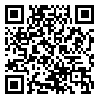Volume 32, Issue 3 (11-2019)
jdm 2019, 32(3): 136-145 |
Back to browse issues page
Download citation:
BibTeX | RIS | EndNote | Medlars | ProCite | Reference Manager | RefWorks
Send citation to:



BibTeX | RIS | EndNote | Medlars | ProCite | Reference Manager | RefWorks
Send citation to:
Najafi M, Semyari H, Sadeghi R, Mashhadiabbas F, Shanei F. The effect of freeze-dried bone allograft and partially demineralized freeze-dried bone allograft on regeneration of rabbit calvarial bone defects: A Histological and histomorphometric study. jdm 2019; 32 (3) :136-145
URL: http://jdm.tums.ac.ir/article-1-5928-en.html
URL: http://jdm.tums.ac.ir/article-1-5928-en.html
Mohammad Najafi1 
 , Hassan Semyari2
, Hassan Semyari2 
 , Rokhsareh Sadeghi2
, Rokhsareh Sadeghi2 
 , Fatemeh Mashhadiabbas3
, Fatemeh Mashhadiabbas3 
 , Fereshteh Shanei *
, Fereshteh Shanei * 
 4
4

 , Hassan Semyari2
, Hassan Semyari2 
 , Rokhsareh Sadeghi2
, Rokhsareh Sadeghi2 
 , Fatemeh Mashhadiabbas3
, Fatemeh Mashhadiabbas3 
 , Fereshteh Shanei *
, Fereshteh Shanei * 
 4
4
1- Assistant Professor, Department of Periodontics, School of Dentistry, Golestan University of Medical Sciences, Gorgan, Golestan, Iran
2- Associate Professor, Department of Periodontics, School of Dentistry, Shahed University, Tehran, Iran
3- Assistant Professor, Department of Oral and Maxillofacial Pathology, School of Dentistry, Shahid Beheshti University of Medical Sciences, Tehran, Iran
4- Post-Graduate Student, Department of Periodontics, School of Dentistry, Shahed University, Tehran, Iran
2- Associate Professor, Department of Periodontics, School of Dentistry, Shahed University, Tehran, Iran
3- Assistant Professor, Department of Oral and Maxillofacial Pathology, School of Dentistry, Shahid Beheshti University of Medical Sciences, Tehran, Iran
4- Post-Graduate Student, Department of Periodontics, School of Dentistry, Shahed University, Tehran, Iran
Abstract: (3428 Views)
Background and Aims: Reconstruction of osseous defects is one of the ideal goals of periodontal treatments and dental implant therapy. Different biomaterials have been used for this purpose and many studies have tried to compare and introduce the best ones. The present study aimed to evaluate the effect of PDFDB (Partially Demineralized Freeze-Dried Bone Graft) and FDBA (Freeze Dried Bone Allograft) on the regeneration of rabbit calvarial defects.
Materials and Methods: In this experimental study, 48 similar defects with the diameter of 8 mm were generated in the calvarium of 16 rabbits. Two defects were filled with FDBA and PDFDB, while the other one remained unfilled as the control group. All defects were covered by collagen membranes. 6 and 12 weeks after surgery, the histologic and histomorphometric tests were performed to evaluate the following variables: the rate of new bone formation and its type, the amount of residual grafting material, degree of inflammation and pattern of bone formation. Comparison of osteogenesis percentage and residual biomaterial was performed by repetitive variance analysis, whereas qualitative variables were compared by Friedman non-parametric test.
Results: Regarding bone formation percentage, there was no statistically significant difference between three different groups at 6-week (P=0.33) and also at 12-week time points (P=0.98). The amount of residual material in the PDFDB group was significantly lower than FDBA (P=0.04) in the 6-week samples. However, this difference was not significant in the 12-week samples (P=0.41). Bone quality showed statistically significant difference between graft containing groups and control group after 12 weeks (P=0.01). It means, all samples in FDBA and PDFDB groups displayed lamellar bone after 12 weeks while in control group, only woven bone or a combination of woven and lamellar bone was seen.
Conclusion: FDBA and PDFDB demonstrated similar regenerating effect in the rabbit calvarial bone defects and hastened bone maturation compared to the non-grafted defects.
Materials and Methods: In this experimental study, 48 similar defects with the diameter of 8 mm were generated in the calvarium of 16 rabbits. Two defects were filled with FDBA and PDFDB, while the other one remained unfilled as the control group. All defects were covered by collagen membranes. 6 and 12 weeks after surgery, the histologic and histomorphometric tests were performed to evaluate the following variables: the rate of new bone formation and its type, the amount of residual grafting material, degree of inflammation and pattern of bone formation. Comparison of osteogenesis percentage and residual biomaterial was performed by repetitive variance analysis, whereas qualitative variables were compared by Friedman non-parametric test.
Results: Regarding bone formation percentage, there was no statistically significant difference between three different groups at 6-week (P=0.33) and also at 12-week time points (P=0.98). The amount of residual material in the PDFDB group was significantly lower than FDBA (P=0.04) in the 6-week samples. However, this difference was not significant in the 12-week samples (P=0.41). Bone quality showed statistically significant difference between graft containing groups and control group after 12 weeks (P=0.01). It means, all samples in FDBA and PDFDB groups displayed lamellar bone after 12 weeks while in control group, only woven bone or a combination of woven and lamellar bone was seen.
Conclusion: FDBA and PDFDB demonstrated similar regenerating effect in the rabbit calvarial bone defects and hastened bone maturation compared to the non-grafted defects.
Type of Study: Research |
Subject:
general
Received: 2020/01/12 | Accepted: 2020/01/12 | Published: 2020/01/12
Received: 2020/01/12 | Accepted: 2020/01/12 | Published: 2020/01/12
Send email to the article author
| Rights and Permissions | |
 |
This work is licensed under a Creative Commons Attribution-NonCommercial 4.0 International License. |


